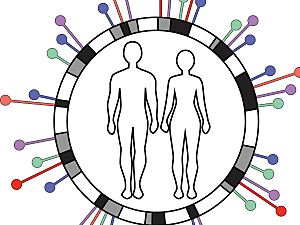Genome-wide association studies (GWAS) of blood samples have identified the genetic basis of certain blood cell traits and their links to common diseases. However, these studies don’t consider the dynamic responses of blood cells to environmental conditions, presumably contributing to their effects on disease development, progression, and prevention.
In a new approach, Brigham and Women’s Hospital researchers combined cellular phenotyping with GWAS to detect previously hidden genomic loci. In Nature Genetics, they explain that they were able to define the genetics underlying distinct subsets of disease and specific pathophysiologic mechanisms that future novel therapeutics might target more directly.
The authors are Max Homilius, PhD, research fellow in the Division of Cardiovascular Medicine, Wandi Zhu, PhD, instructor in the Division, Calum A. MacRae, MD, PhD, vice chair of Scientific Innovation in the Department of Medicine, Rahul C. Deo, MD, PhD, lecturer in the Division, and colleagues.
Expanding the Phenotypic Space of Blood Profiles
The researchers adapted a widely used whole-blood cytometry analyzer (Sysmex XN-1000) to profile peripheral blood from 4,723 individuals under baseline conditions and 36 perturbations (various stressors). They genotyped 2,685 of the blood donors and performed GWAS for all blood perturbation profiles.
Compared with the baseline, each perturbation evoked particular changes in the characteristics of different blood lineages, resulting in a series of distinct cellular profiles. This expanded quantification for each donor from 278 cell readouts to more than 4,000, on average.
By linking the evoked blood-response readouts with lab values and diagnostic codes, the team identified clusters of clinical traits, disease syndromes, and genetic loci, suggesting the readouts give information about specific biological processes.
Perturbational Conditions Yield New Genetic Associations
The team tested associations of 278 cellular phenotypes in the 37 perturbational conditions against >3.5 million imputed genetic variants in 260 to 2,200 donors. They identified 48 unique, nonoverlapping regions with nearby candidate genes:
- 25 of the 48 genetic regions had been described previously as blood biomarker associations
- For 12 of the 25 regions, the researchers observed new associations in previously unreported cell types
- The other 23 regions associated with blood cell responses to perturbations had never been reported
Blood Perturbation Responses Reflect Organ-specific Disease Traits
The team tested for associations between 327 evoked blood-response readouts and a collection of phenotypes drawn from electronic health records. The diagnostic status for multiple common disorders was substantially associated with readout variations.
Significant associations included certain clinical traits not directly measurable in blood, such as QT interval on an electrocardiogram. This suggests that some of the newly identified blood phenotypes reflect physiological changes occurring in other tissues.
Polygenic Scores for Diverse Blood Readouts Predict Disease Outcomes
Using polygenic scores (PGSs) derived from the same 327 blood readouts, the researchers computed proportional hazard models for 30 clinical outcomes. They performed meta-analyses to identify blood traits and clinical outcomes with robust associations in the Mass General Brigham Biobank and the UK Biobank.
Some PGSs showed utility for stratifying patient populations and improving the prediction of multiple cardiometabolic conditions (e.g., obesity, type 2 diabetes, chronic kidney disease, and heart failure) and immune-related conditions such as type 1 diabetes, asthma, and systemic lupus erythematosus. This implies genetic factors influencing various blood traits might prove useful for predicting disease outcomes.
Independent component analysis revealed meaningful clusters of clinical phenotypes, such as a group involving lipidemia, chronic ischemic heart disease, and heart failure. These subgroups might benefit from therapeutics that target related biological pathways.
Conclusions
This framework incorporating human genetic data, cellular phenotyping, and clinical traits allows identification of common genetic variants that are major contributors to certain diseases and clinical outcomes. The method could be extended to systematic target validation and subsequent drug discovery.
Furthermore, implementing the method in routine clinical settings could refine predictions of clinical trajectories.
Given that biological pathways are redundant across diverse tissues and organ systems, insights into whole blood may be relevant to a range of conditions originating in different tissues.
